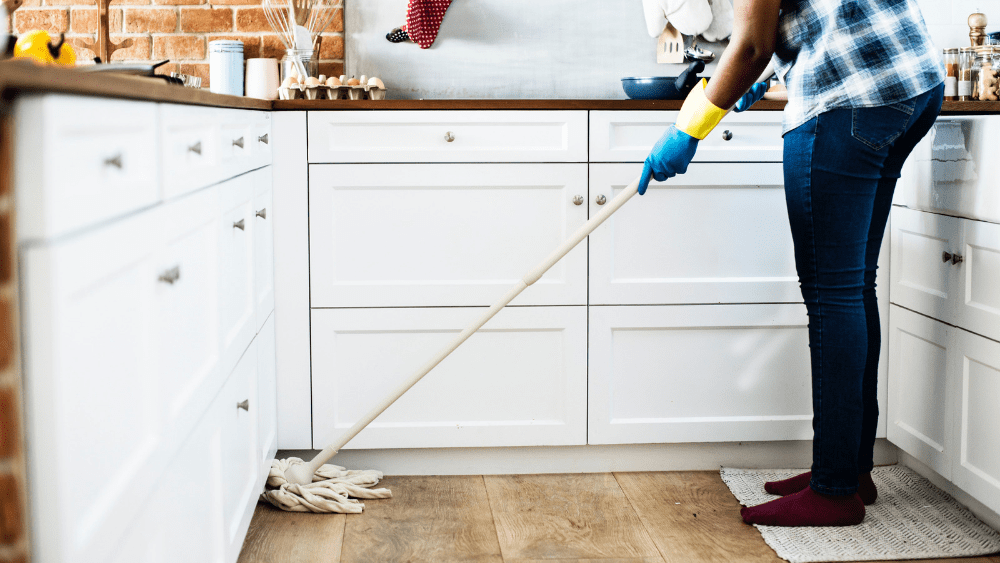
The term “spring cleaning” tends to get thrown around a lot – even when it’s not technically spring. Regardless of the weather outside, “spring cleaning” can be both a daunting and rewarding task. While organizing and cleaning every single room in your home can sound like a drag, it’s a great way to purge what you don’t need and declutter, which can lead to a more peaceful feeling home.
However you feel about a deep clean, here are a few tips to make it more productive — and, dare we say, more enjoyable.
Organize First
There’s no point in deep cleaning around stuff. You need to get a handle on the clutter before anything else, especially if you only do a deep clean once a year, leaving you with 12 months’ worth of stuff.
Tidying expert Marie Kondo has developed a process for decluttering and organizing that has changed the lives of millions of people worldwide.
Her two-part approach is simple: First, put your hands on everything you own and ask yourself if it “sparks joy.” No? Say goodbye. Once you have only your most beloved and used possessions left, organize them in such a way that everything has a home, is visible and easily accessible.
Where To Start: Declutter
If you’re like most people, you’ve probably always tackled deep-cleans one room at a time. Kondo advises against this, as people tend to just move their stuff from one room to the next, shuffling the mess. Instead, she suggests decluttering and organizing by category. All the clothes in your entire house, then all the books in your house, then all the kitchen gadgets in your house – you get the idea.
Kondo suggests starting with clothes, as they’re the least sentimental, then working your way toward items that may be harder to part with, such as greeting cards, letters, and old photos. Designate one or two storage bins for those sentimental items you simply can’t part with, and store them safely out of sight in a single place, rather than in drawers all over the house.
She also warns against getting distracted while working on a category. For example, when going through your clothes, you need to blatantly ignore the old shoebox with your child’s art tucked away at the top of your closet. That category is for another day.
This article provides a great overview of Kondo’s decluttering and organizing process, specifically for clothes.
Storage Solutions
While drawer separators, closet organizers, and storage bins can be useful, you may find that after paring down your possessions, you don’t need all of that.
When you do need a storage solution, though, Kondo advises keeping everything highly visible and accessible. Don’t purchase a black bin with a black lid for storing items. Out of sight, out of mind! You may realize as the year goes on that you don’t really use or need the extras, allowing you to give them up and gain some extra space.
This tip is extra important for spaces such as the garage or storage shed, where it’s common to store items that are used sparingly, such as holiday décor, power tools, and more. Store your tools so they’re clearly visible on a shelving system or pegboard. For Christmas decorations, it’s time to purge anything you don’t truly love and keep only the pieces that spark joy. For those, store in a clear, labeled storage bin.
Getting Rid of Stuff
This is where a lot of people get stuck. It’s easy enough to say you don’t need or want something anymore, but for many, there’s guilt associated with throwing away or even donating certain items — especially things you spent money on.
To sort items you’d like to purge, make three piles:
1. Sell/Consign. Items in like-new condition may be sold or consigned. This might be time-consuming, but if recouping money is important to you, then it’s time well spent. Sites and apps such as Facebook Marketplace and Let Go make it easier than ever to get fast, wide exposure for your available items. If you have a local consignment shop for household goods or children’s clothes, you can take your items in for valuation.
2. Donate. Items in used-but-good condition should be donated. Research your local thrift stores and try to find a nonprofit charity store that uses its proceeds to benefit the community. Be considerate when dropping off donations. Fold clothes, wrap delicate items, and have a general organization system – don’t dump a jumbled box at the nearest Goodwill and drive off. Don’t forget to get a receipt for tax time!
3. Recycle/Trash. For items that can’t be salvaged, this is the last resort. First, see what can be recycled. Many electronics stores and thrift stores, and even some cities, have recycling programs for outdated computers, televisions, etc. This allows them to be properly disposed of and keeps them out of the landfill. If you end up with a large pile that’s truly trash, call your waste management company to schedule a bulk pickup.
The Deep Clean
Once you’ve decluttered and organized your home, it’s time to do the real cleaning!
Now, it is easier to go room by room. Always move from to the top down. Use a long-handled duster to knock down cobwebs, dust fans, and clean air vents on the ceiling. Then, dust bookshelves, pictures, mirrors, and furniture. Once the dust settles, tackle the baseboards. Finally, do the floors. Take the time to move furniture and do a thorough job. You’ll be glad you did when you see the results!
For windows, if you don’t have a big house, it may be worth your time and pure sanity to hire a professional window cleaning company. If you want to DIY it, try these tips from Good Housekeeping to make quick work of the job.
Don’t forget the garage! This handy guide from Budget Dumpster can help you get a handle on garage clutter. Basically, you should pull everything out into the driveway first. Then go through it and decide what to keep, sell, donate, and trash. Next, deep clean the space and reorganize everything. And don’t forget Kondo’s advice: What you do keep, keep it visible and accessible.
Ready to tackle a deep-clean? It’s the perfect time to evaluate what you own and to declutter, organize and deep clean every inch of your home. You’ll finish the job (days or weeks later, who cares!) feeling lighter, more confident and full of joy!

Liyya Hassanali is a Project Manager and Content Strategist for Kinship Design Marketing, a boutique agency that provides marketing strategies and content for architects, interior designers, and landscape designers. She is a 15+ year veteran of the marketing and advertising industry, working closely with her clients to provide written content that meets their marketing goals and gets results.
Liyya is passionate about home design and décor and is a confessed HGTV and Pinterest addict. When not providing content writing services for her clients, she can be found browsing home décor sites or spending time with her family.

 How To Choose Sculptural Lighting for Your Home
How To Choose Sculptural Lighting for Your Home